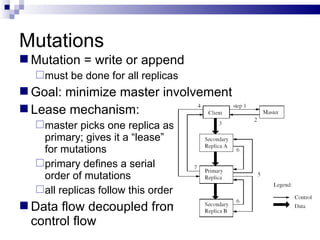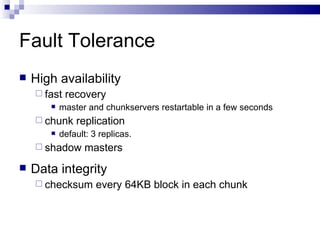Distributed computing seminar lecture 3 - distributed file systems
- 1. Distributed Computing Seminar Lecture 3: Distributed Filesystems Christophe Bisciglia, Aaron Kimball, & Sierra Michels-Slettvet Google, Inc. Summer 2007 Except as otherwise noted, the content of this presentation is © Copyright University of Washington and licensed under the Creative Commons Attribution 2.5 License.
- 2. Outline Filesystems Overview NFS (Network File System) GFS (Google File System)
- 3. Filesystems Overview System that permanently stores data Usually layered on top of a lower-level physical storage medium Divided into logical units called “files” Addressable by a filename (“foo.txt”) Usually supports hierarchical nesting (directories) A file path joins file & directory names into a relative or absolute address to identify a file (“/home/aaron/foo.txt”)
- 4. Distributed Filesystems Support access to files on remote servers Must support concurrency Make varying guarantees about locking, who “wins” with concurrent writes, etc... Must gracefully handle dropped connections Can offer support for replication and local caching Different implementations sit in different places on complexity/feature scale
- 5. NFS First developed in 1980s by Sun Presented with standard UNIX FS interface Network drives are mounted into local directory hierarchy
- 6. NFS Protocol Initially completely stateless Operated over UDP; did not use TCP streams File locking, etc., implemented in higher-level protocols Modern implementations use TCP/IP & stateful protocols
- 7. Server-side Implementation NFS defines a virtual file system Does not actually manage local disk layout on server Server instantiates NFS volume on top of local file system Local hard drives managed by concrete file systems (EXT, ReiserFS, ...) Other networked FS's mounted in by...?
- 8. NFS Locking NFS v4 supports stateful locking of files Clients inform server of intent to lock Server can notify clients of outstanding lock requests Locking is lease-based: clients must continually renew locks before a timeout Loss of contact with server abandons locks
- 9. NFS Client Caching NFS Clients are allowed to cache copies of remote files for subsequent accesses Supports close-to-open cache consistency When client A closes a file, its contents are synchronized with the master, and timestamp is changed When client B opens the file, it checks that local timestamp agrees with server timestamp. If not, it discards local copy. Concurrent reader/writers must use flags to disable caching
- 10. NFS: Tradeoffs NFS Volume managed by single server Higher load on central server Simplifies coherency protocols Full POSIX system means it “drops in” very easily, but isn’t “great” for any specific need
- 11. The Google File System Sanjay Ghemawat, Howard Gobioff, and Shun-Tak Leung SOSP 2003 (These slides by Alex Moshchuk, University of Washington – used with permission)
- 12. Motivation Google needed a good distributed file system Redundant storage of massive amounts of data on cheap and unreliable computers Why not use an existing file system? Google’s problems are different from anyone else’s Different workload and design priorities GFS is designed for Google apps and workloads Google apps are designed for GFS
- 13. Assumptions High component failure rates Inexpensive commodity components fail all the time “ Modest” number of HUGE files Just a few million Each is 100MB or larger; multi-GB files typical Files are write-once, mostly appended to Perhaps concurrently Large streaming reads High sustained throughput favored over low latency
- 14. GFS Design Decisions Files stored as chunks Fixed size (64MB) Reliability through replication Each chunk replicated across 3+ chunkservers Single master to coordinate access, keep metadata Simple centralized management No data caching Little benefit due to large data sets, streaming reads Familiar interface, but customize the API Simplify the problem; focus on Google apps Add snapshot and record append operations
- 15. GFS Architecture Single master Mutiple chunkservers … Can anyone see a potential weakness in this design?
- 16. Single master From distributed systems we know this is a: Single point of failure Scalability bottleneck GFS solutions: Shadow masters Minimize master involvement never move data through it, use only for metadata and cache metadata at clients large chunk size master delegates authority to primary replicas in data mutations (chunk leases) Simple, and good enough!
- 17. Metadata (1/2) Global metadata is stored on the master File and chunk namespaces Mapping from files to chunks Locations of each chunk’s replicas All in memory (64 bytes / chunk) Fast Easily accessible
- 18. Metadata (2/2) Master has an operation log for persistent logging of critical metadata updates persistent on local disk replicated checkpoints for faster recovery
- 19. Mutations Mutation = write or append must be done for all replicas Goal: minimize master involvement Lease mechanism: master picks one replica as primary; gives it a “lease” for mutations primary defines a serial order of mutations all replicas follow this order Data flow decoupled from control flow
- 20. Atomic record append Client specifies data GFS appends it to the file atomically at least once GFS picks the offset works for concurrent writers Used heavily by Google apps e.g., for files that serve as multiple-producer/single-consumer queues
- 21. Relaxed consistency model (1/2) “ Consistent” = all replicas have the same value “ Defined” = replica reflects the mutation, consistent Some properties: concurrent writes leave region consistent, but possibly undefined failed writes leave the region inconsistent Some work has moved into the applications: e.g., self-validating, self-identifying records
- 22. Relaxed consistency model (2/2) Simple, efficient Google apps can live with it what about other apps? Namespace updates atomic and serializable
- 23. Master’s responsibilities (1/2) Metadata storage Namespace management/locking Periodic communication with chunkservers give instructions, collect state, track cluster health Chunk creation, re-replication, rebalancing balance space utilization and access speed spread replicas across racks to reduce correlated failures re-replicate data if redundancy falls below threshold rebalance data to smooth out storage and request load
- 24. Master’s responsibilities (2/2) Garbage Collection simpler, more reliable than traditional file delete master logs the deletion, renames the file to a hidden name lazily garbage collects hidden files Stale replica deletion detect “stale” replicas using chunk version numbers
- 25. Fault Tolerance High availability fast recovery master and chunkservers restartable in a few seconds chunk replication default: 3 replicas. shadow masters Data integrity checksum every 64KB block in each chunk
- 26. Performance
- 27. Deployment in Google Many GFS clusters hundreds/thousands of storage nodes each Managing petabytes of data GFS is under BigTable, etc.
- 28. Conclusion GFS demonstrates how to support large-scale processing workloads on commodity hardware design to tolerate frequent component failures optimize for huge files that are mostly appended and read feel free to relax and extend FS interface as required go for simple solutions (e.g., single master) GFS has met Google’s storage needs… it must be good!
- 29. Next Time... Start learning about algorithms for distributed computation Clustering Algorithms




























